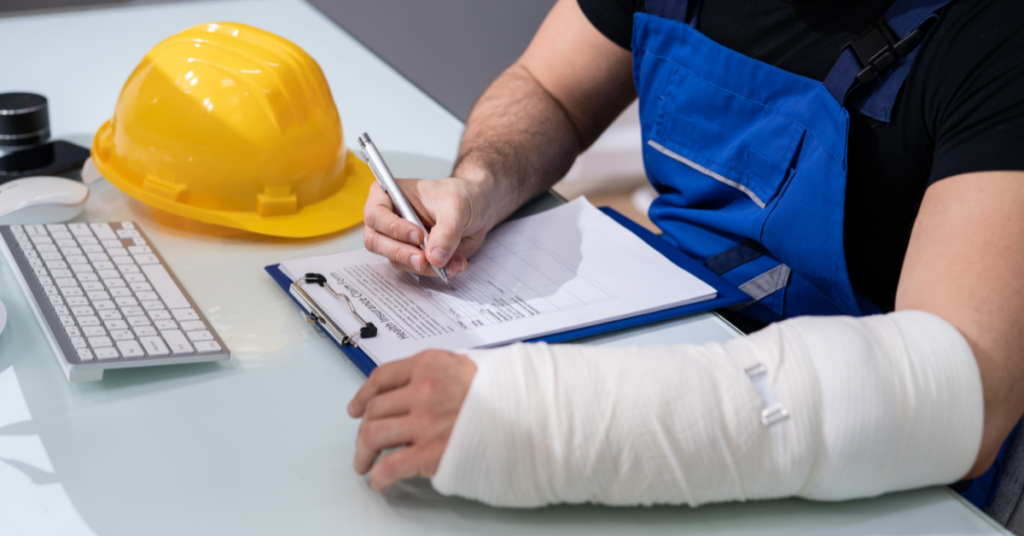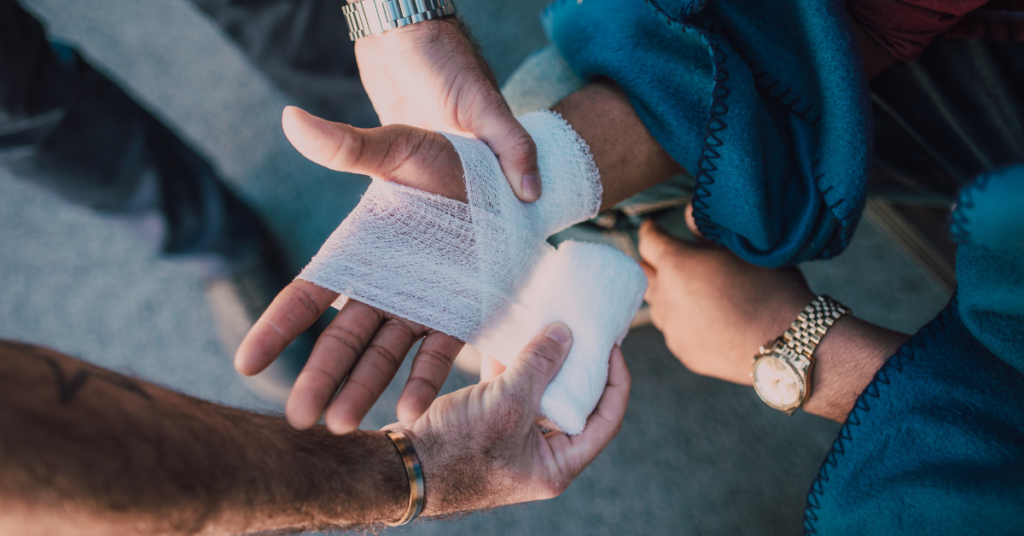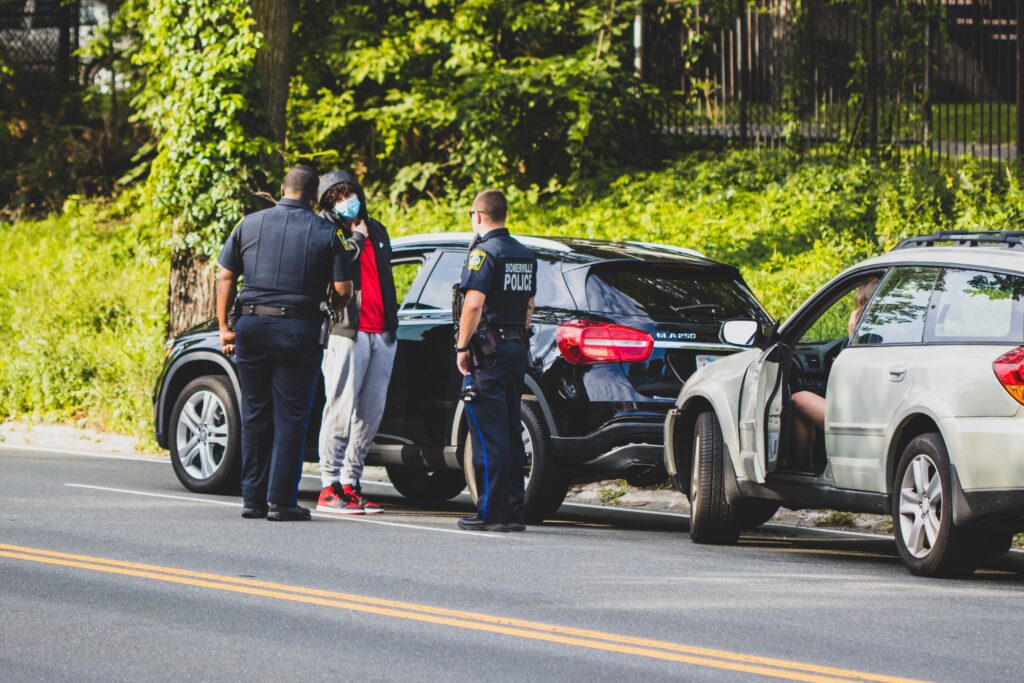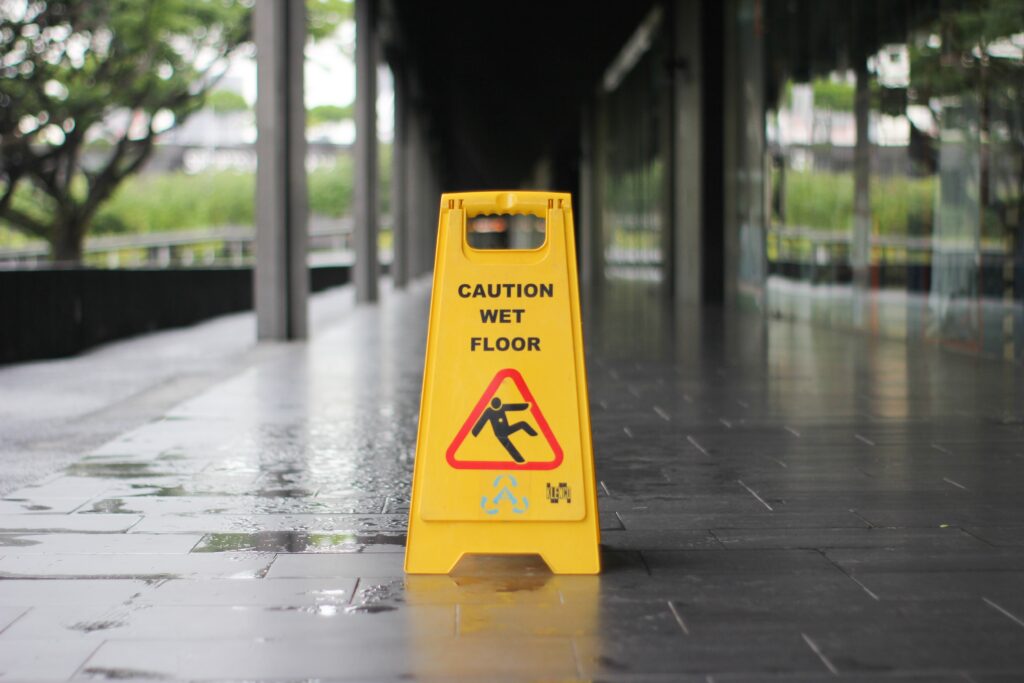
Creating a safe and healthy workplace is the responsibility of all employers, and most companies and business take that responsibility seriously. Even so, according to the National Safety Council, one worker gets hurt on the job every seven seconds—that adds up to approximately seven million workplace injuries per year.
Fortunately, the American workforce is covered by workers’ compensation insurance, a no-fault, government-mandated insurance program that pays monetary benefits to workers who get hurt or become disabled in the course of their employment. Typically, whenever a work-related injury needs medical attention, employers must provide treatment to the injured worker at no cost to them. In addition, depending on the severity and consequences of the injury, there may be other workers’ compensation benefits available.
Common workers’ compensation claims include sprains, strains, cuts, bruises, punctures, and fractures. More complex workers’ compensation claims may involve slip and fall accidents, repetitive motion injuries, vehicle accidents, overexertion injuries, and occupational illnesses.
Other work-related injuries that are less common and serious enough to trigger claims include diseases caused by occupational exposure to chemicals, toxic substances, or environmental contaminants, electric shock, burns, hernias, hearing loss, dental injuries, loss of vision, amputations, organ damage, and mental health injuries.
Minimizing workers’ compensation claims is in the best interest of everyone, employers and employees alike. The following strategies can help create a safer workplace:
· Use Personal Protective Equipment (PPE)
Wearing PPE is critical to protecting those working with hazardous materials from injury.
· Rotate Employees
The longer a worker is in a dangerous environment, the greater their risk of injury. Rotate your team through all the jobs and tasks so no one spends too much time in the riskiest spot.
· Eliminate Hazards
Get rid of hazardous elements such as gas or other flammable liquids, provide proper ventilation, and ensure adequate disposal methods will reduce illness and injury.
· Provide Training
Creating a learning environment focused on safety will promote a healthier workplace.
· Recruit a Safety Committee
A cross-section of employees, team leaders, and management demonstrates that safety and health are a priority and motivate everyone to act accordingly.
Despite everyone’s best efforts, however, injuries and illness still occur on the job. If you have been injured on the job, you are entitled to receive workers’ compensation. Some injuries may have allowed you to return to work with certain restrictions or limitations, while others may be preventing you from working at all. Other injuries, especially sprains, strains, and repetitive use injuries, may be causing you lingering pain that has created an ongoing impairment. In these cases, a workers compensation lawyer can help you apply for permanent disability benefits.
For example, an experienced workers’ compensation lawyer like Arthur C. Crum can help you obtain all the benefits you are entitled to receive. If you had a work-related injury that has caused a permanent disability, Arthur C. Crum will advocate for you against insurance claims administrators who want you to settle for less than you are entitled to under the law. To discuss your potential workers’ compensation case with one of the most experienced personal injury attorneys in Maryland, Virginia, and West Virginia, call Arthur C. Crum today.

When it comes to motorcycle accident prevention, it is important to know that while yes,
motorcycle accidents do in fact happen every single day, many of these are easily avoidable simply by being careful. It’s also critical to be aware of the fact that there are others on the road and so you need to know how to share the road with motorcyclists.
Some of the most common causes of motorcycle accidents include:
- An increased number of motorcycles actually being on the road. Motorcycles use less gas, and as gas prices have continued to increase a lot of people are now driving motorcycles rather than cars which impacts motorcycle safety for cars too.
- More motorcycle riders hitting the road means that now there is in essence a lot of, “new motorcycle drivers,” joining the road all at once. A lack of experience also means an increase in the risk of having an accident.
- Automobile drivers who don’t always check their blind spots before merging or switching lanes. Motorcycles are smaller than cars, and if you don’t look carefully, they can be harder for you to see.
Thankfully, there are many different ways that you can help to reduce the risk of having an accident that involves a motorcycle. And here are just a few tips for safely sharing the road with motorcycles.
- First, as a car driver, be aware that motorcycles are on the road, and as mentioned earlier, now there are even more of them out there. So be aware of their presence, and also be sure to always check your blind spots carefully.
- Watch out for bad weather. Remember that bad weather is greater on a motorcycle than on a car. Rain is physically hitting the driver’s body in addition to pelting down on their bike. So just keep in mind weather makes driving even harder on a motorcyclist than it does for a person who’s driving a car.
- Give motorcycles more room. If you hit a car from behind, yes, that’s bad, but it’s likely to cause a lot less damage than it could cause if you should hit a motorcycle from behind. That’s because a motorcyclist might be thrown off their bike, and it could end up becoming a fatal accident as a result.
- Don’t attempt to “Lane-Share.” A driver on a motorcycle has the same rights and responsibilities when comes to regards to using the actual physical space on the road itself. Don’t think, “Oh, hey, they’re small, and I have a little car, and so, I can just drive in the same lane beside the bike for a minute until I can pass them.” It’s just not worth the risk, and besides, legally that motorcycle has the exact same right to have the same space in their own lane just like a car has.
- Use your turn signal. That indicator is there for a reason. It’s important for any driver to always use their turn signal, but that’s even more true if you are on the road along with motorcycles, especially if that motorcyclist is driving behind your car.
Hopefully, these suggestions will help you prevent any mishaps on the road, and they should also help you avoid motorcycle accidents in the future.

Coping with the death of a loved one is always difficult, but when that death may be the result of another’s negligence or wrongful conduct, survivors often need support to find closure and peace. In these cases, many families reach out to an experienced wrongful death attorney to discuss whether they have grounds to file a lawsuit to hold the responsible parties accountable.
What is a Wrongful Death Claim?
A wrongful death claim exists when a person dies due to the legal fault of another person. Wrongful death claims involve all types of fatal accidents—from simple car accidents to complicated medical malpractice cases. Persons, companies, and governmental agencies can be legally at fault for acting negligently (failing to act as a reasonable person would have acted) and for acting with malicious intent.
Who Can File a Wrongful Death Claim?
A suit alleging death by negligence must be filed by a representative on behalf of the survivors who suffer damage from the decedent’s death, including spouses, children, parents, and other immediate family members.
Filing A Wrongful Death Suit
Per the Maryland Bar, the surviving members of the victim’s family may either be awarded compensation by the court or offered a settlement by either the defendant or their insurance company if they can prove:
- That the defendant acted negligently.
- That the defendant’s negligence caused the death of the decedent.
- That the decedent has a surviving spouse, children, or other dependents and/or beneficiaries of their estate.
- That these survivors suffered economic damage as the result of the decedent’s death.
Compensation for Negligence Resulting in Death
In general, the types of damages that may be available to the survivors in a wrongful death lawsuit include economic compensation for the financial contributions the victim would have made to the survivors, medical costs associated with the death, and funeral expenses. Damages in suits claiming death by negligence may include compensation for the survivors’ mental anguish, pain and suffering, and other damages including the survivors’ losses of care, protection, companionship, and consortium.
While nothing can compensate for the loss of a loved one, prevailing in a wrongful death suit can provide survivors with a sense of closure as well as the funds they need to move forward. If you believe a loved one has died due to negligence or an intentional act, you should speak to an attorney about filing a wrongful death suit as soon as possible.
A wrongful death lawsuit must be filed in the court with jurisdiction over the case, which usually means filing the claim where the death occurred. Maryland Attorney Arthur C. Crum is an experienced litigator who works with families in Western and Central Maryland, including Frederick, Washington, Allegany, and Garrett Counties. Reach out to the Law Office of Arthur Crum, PA to discuss if your loved one has suffered death by negligence.

Safety should always be a year-round priority in the workplace, but as we steel ourselves for the snow and ice that often accompany this time of year, it makes sense to look at the most common cold weather injuries and what can be done to prevent them.
Let’s start by taking a look at the most common types of cold weather injuries in the workplace and what employers should do to be prepared:
1. “Slip, Trip, and Fall” injuries happen year-round in the workplace. Indoors or outside, something like an unmarked door sill, uneven pavement, or a steep stairwell can cause serious injury. But when temperatures plummet and ice and snow become a factor, the risk of these injuries skyrockets.
When the storm clouds gather and the temperature drops, doing the following will go a long way toward heading off serious incidents:
· Inspect outside areas and entrances for any wet, cold, or slippery surfaces.
· Salt and de-ice heavily-used areas as soon as possible.
· Place cones or warning signs in hazardous areas until they can be cleared.
· Have labor, materials, and equipment primed and ready to clean snow and ice from parking lots and walkways immediately.
2. Workplace Vehicle Accidents are also more prevalent in cold weather due to frost, black ice, and snow. When your employees have to travel to complete their job responsibilities, workers’ compensation covers any accidents or injuries that occur. Many employers require those who drive on the job to complete a defensive driving training course, with special emphasis on strategies for driving more safely in cold weather such as:
· Avoiding tailgating; keeping larger distances between vehicles on the road.
· Leaving the road safely in intense weather.
· Assuring that windshield wiper fluid, wiper blades, headlights, and defrosters are working well.
· Packing weather-related tools such as salt and shovels in the vehicle in case of emergency.
3. Electric Shock, Burns, and Workplace Fires
The lower the temperature, the less stable and consistent the power grid is. That’s why winter brings with it a spike in these types of injuries, especially among those whose job it is to repair downed power lines and perform building maintenance. Because the power supply is less predictable at lower temperatures, surges that cause burns and lacerations are more common.
· The best thing you can do is to make it clear to your employees—especially the maintenance staff—that only a trained professional should attempt to handle a live power line or perform electrical work in your workplace.
· Provide information to everyone about who to call in the event of a short circuit or power surge.
4. Exposure Injuries
If you have employees who work outdoors between November and March in the quad-state area, guard against injuries caused by cold temperatures including frostbite and hypothermia. Provide protective equipment and clothing such as functional gloves, footwear, and outerwear. Be sure clothing is fitted properly so that rain and snow does not get into your workers’ eyes. Footwear should not only keep workers’ feet from getting cold; it should also provide the best traction possible to avoid slips, trips, and falls.
· Ensure that your outdoor crews wear the protective clothing you provide for them. It’s especially crucial that they wear gear that protects their ears, fingers, and toes.
· Make sure your employees who work outdoors know and understand the signs of frostbite and hypothermia. Urge them to act promptly if they experience any of them.
Identifying and planning for the cold weather injuries that occur during the winter in Western and Central Maryland is the most important thing you can do as an employer to keep your workers safe on the job. Using these winter safety tips for the workplace will go a long way toward minimizing workers compensation claims. And remember: with a bit of planning and adequate preparation, you can prevent many of the most common cold-weather workplace injuries.

Even the most careful driver can have a car accident in winter. Limited visibility, icy roads, and careless fellow drivers can all contribute to a winter driving mishap—and all those things are out of your control. To feel safer and minimize your risk of more serious damage to yourself, your passengers, or your automobile, remember these six steps that are within your control.
1. Move to a Safe Place
If you’re able to move your car, get it out of the paths of other vehicles. If not, get yourself and your passengers out of the car. Especially in snow-related car accidents, other vehicles could slide and skid into your automobile, turning a minor accident into something more serious.
2. Call 911 and/or Contact the Police
Once you’re out of harm’s way, get immediate medical attention for anyone injured in the accident. It’s a good idea to file a police report to document the details in the moment in case you have trouble recalling details in the future. Stay calm, don’t speculate, and avoid placing nor assuming blame. Stick to the facts.
3. Write Down the Information
Write down the information of the other driver or drivers, including their names, addresses, phone numbers, drivers’ license numbers, and insurance information. Look around for any witnesses and get their contact information, too.
4. Preserve the Evidence
That cell phone in your purse or back pocket can come in handy here. Take pictures of your injuries, damage to your car, the accident scene, any poor road conditions, limited sight lines, or covered road signs—anything that may have contributed to the accident.
5. Call Your Insurance Company
Report the accident to your insurance company but don’t consent to a recorded statement.
Don’t talk to the insurance companies of the other drivers involved. Leave that to your insurance company or attorney.
6. Contact an Auto Accident Attorney
Car accidents aren’t everyday occurrences for any of us, so knowing how to handle one when the pressure is on is tough under any circumstance. They’re even more difficult to handle if you or a passenger is injured. Calling on an experienced attorney will go a long way to helping you cope with the issues that may result from a winter driving accident. An attorney who is skilled in handling auto accident-related claims won’t let an insurance company take advantage of you. If you must deal with chronic pain, lost time at work, or medical bills, you deserve to be compensated.
If you need an auto accident attorney in Maryland, call the Law Office of Arthur Crum.
He is a Maryland attorney who represents individuals who have been injured due to vehicle accidents (including car, motorcycle, and commercial truck accidents). If you’ve been injured in a car accident, you can count on us to work hard to obtain you all the benefits and compensation you are entitled to recover under the law.
There are approximately 6 million car accidents every year, and while most of these are not fatal, many do result in personal injury and vehicular damage. If it happens to you during this winter driving season, follow these steps and remember: you can reach out by phone or email to get the legal help you need from the Law Offices of Arthur Crum.

Were you injured at work?
When you need workman’s comp attorneys you can trust, Arthur Crum will help you navigate Maryland workman’s comp laws. Here are the details you need to know about workman’s comp from the firm where the client is always our first priority.
What is Workman’s Comp in Maryland?
In Maryland, workman’s compensation covers work-related illnesses and injuries that happen while on the job. It is a type of no-fault insurance that employers carry. If you suffer a workplace injury, you are entitled to:
- Two-thirds of your lost wages
- Disability benefits
- Doctor’s visits, treatments, and prescriptions
- Any ER trips or hospitalization
- Necessary surgical procedures
- Physical therapy
- Equipment for physical assistance
- Modifications to your home
- Some vocational training
According to workers’ comp in Maryland, you are entitled to death benefits if someone dies due to a work-related injury or illness.
Who Carries Workman’s Comp Insurance?
Maryland law requires businesses with one full- or part-time employee to carry workers’ comp insurance. Agricultural companies with less than three employees and a payroll of less than $15,000 per year are exempt.
To file a claim, you do not have to prove employer negligence, and laws are in place to protect you from retaliation. Businesses that do not carry the required coverage can be fined up to $10,000. If your boss tries to deduct any of these costs from your paycheck, it’s a misdemeanor.
How do I Know if I’m Eligible?
You are not eligible for benefits if you are:
- An independent contractor
- A business partner
- A sole proprietor
You must be an employee that works for someone else. You are an employee if your boss:
- Pays you a salary, whether hourly, weekly, or monthly
- Schedules your working hours
- Informs you of when you can take lunch and breaks
- Provides the tools you need to do your job
- Directly supervises your work
- Pays for work or travel expenses
- Provides employee benefits, like PTO days
What Claims Might be Denied?
Your place of business may fight or deny your Maryland claim if your situation:
- Is not work-related
- Was self-inflicted
- Happened while you were impaired by alcohol or drugs
- Happened while you were involved in illegal activities
- You have a pre-existing medical condition that brought this on
Denied claims can be appealed with the help of your attorney through an MWCC hearing, the Maryland Circuit Court, or the Maryland Appellate Court.
How do I Report a Claim?
Here are the steps you need to take immediately if you or someone you love is injured at work.
- In writing, report it immediately at work, and provide proof (like a medical report or photos). Although you have ten days to tell your employer, do not delay.
- All illnesses due to working conditions or hazards must be reported within one year. Again, this is not something you should delay. Report it to your workers’ comp representative as soon as possible.
- Make sure an Employer’s First Report of Injury form is submitted on the MWCC website by your place of business.
- Seek immediate medical treatment. Ask for documentation from your doctor or healthcare provider. Follow all advice and plans of treatment without fail. If you are given a prescription for medication, take it only as prescribed.
- Fill out and then submit the Employee Claim Form C-1 on the MWCC website. Ask that a hard copy be mailed upon receipt. You have 60 days to complete this, yet time is of the essence, so please complete it as soon as possible.
With FREE initial consultations, it’s worth the call to Arthur Crum, who will work hard to ensure you’re compensated. He is the personal injury attorney in Frederick, MD, whom you can trust. Make the call!

It’s hard enough to cope with being in a car accident. Dealing with an insurance claims adjuster who sees you as just another case number is an additional stressor you don’t need. Not everyone understands the ins and outs of dealing with auto insurance adjusters. How do you navigate the claim and settlement process? If you need a Maryland auto accident attorney, the Law Office of Arthur Crum is here to help you step by step and also to help you determine when it’s time to have a car accident lawyer by your side.
Start the Claim Process ASAP
After you contact first responders and let loved ones know you’re okay, your next call should be to your insurance agent. Start the claim process as soon as possible. The sooner you recount the events, the better your memory of all the details.
Detail Everything
Write down everything while it’s fresh. Take photos of the accident scene if possible. Exchange information with the other parties and witnesses. This also includes keeping accurate records of hospital visits, doctor bills, car repairs, police reports, and additional pertinent information. It may help to file it in chronological order rather than group it by category. That way, when you need something from a specific date, you can have it in hand quickly.
A Fair Settlement
Calculating a fair settlement isn’t a guessing game. When finding an accurate figure, you should account for:
- Medical care and related expenses
- Any income lost due to injuries
- Long-term medical care or loss of employment due to disability
- Pain and suffering
- Repairs to or replacement of your vehicle
This is a good starting point for a ballpark estimate: a minimum acceptable amount.
Detailed Demand Letter
After you add up a fair settlement amount, it’s time to send your insurance company a demand letter. You should include:
- Description of the accident
- Details of your injuries
- Medical treatment received
- Ongoing health issues as a result
- Vehicle damage
- Losses incurred as a result
- The total amount you find acceptable
They will likely reply with an offer lower than the requested amount, so consider adding 25 to 100% more in your demand letter. Again, this is why it is crucial to keep detailed records of everything. No evidence can leave you with less money in your pocket when you deserve more.
Never Accept the First Offer
Your insurance company’s priority is not looking out for your best interests. They are in the business to maximize profits.
When you first receive an offer, it may be low. That’s a tactic to see how quickly you will settle and if you honestly understand what your claim is possibly worth. Ask for specific reasoning behind every dollar offered. Do not propose a lower figure from your original ask. Wait for the insurance company to counter.
Stay Focused
Remember to always emphasize the points in your favor when communicating with your adjuster. Be focused on what’s essential. Talk about your quality of life, how your finances have suffered, what this means for you work-wise due to a loss of transportation, and how this impacts your family. Make it clear that you expect to be compensated fairly.
Always Get it in Writing
Always, always, always take detailed notes about your conversations with your insurance company. Get all settlement offers in writing. If you reach an agreement, ensure all dates and dollar amounts are in the contract and signed by the relevant parties.
If you find at any time that you are not making progress with your claim or your insurance adjuster is less than sympathetic and not taking you seriously, it’s time to contact the office of Arthur Crum. We have championed the rights of individuals in Western and Central Maryland who have been injured to ensure they are compensated. Our client is always our first priority. Let us help you maximize your case’s outcome. Contact us today!

Car accidents: they can happen in the blink of an eye. Once the shock wears off, witnessing one can leave you with questions. That’s why the Law Office of Arthur Crum, PA, has put together a list of the dos and don’ts you need to know before you become a traffic accident witness.
Do
Ensure Your Safety First: Stay calm, remain cool, and collect yourself before responding. If able, immediately pull over to the side of the road and attempt to keep a 100-foot distance between you and the accident scene, then turn on your hazard lights. Keep your vehicle clear of inbound traffic, broken glass, fuel leaks, and flames.
Call 911: Call first responders immediately. Never assume someone else will. Even if a crash looks like a minor fender bender, always confirm what you saw. Some states require witnesses to pull over and report, so know the laws concerning car accident witnesses in your area.
Check on All Victims: Once you and your automobile are safe and have alerted the police, check crash victims’ conditions. Make sure that they are safe and help if able. Although this can be a heated or emotional moment for those involved, remember you are a witness who needs to stick to the facts of what you observed. Do not assess blame on anyone nor pass judgment.
Stabilize Vehicles and Victims: If a vehicle fire is imminent, help drivers and passengers to safety. Otherwise, do not move injured parties. Although you may want to rush to help, you could unintentionally make their injury worse. Let the medical professionals do their job. Comfort and reassure those hurt that help is coming.
Provide a Statement and Contact Information: Give the authorities all relevant facts and contact information. You may be asked down the road for more details or to be a source for insurance agents, medical claims, or the authorities. Always be honest and factual, and stay consistent with your account.
Don’t
Rush Onto the Scene: Being cautious is critical. Although you may want to leap into action to help, be careful. The last thing you want is to become an additional victim when paramedics arrive.
Fear Liability: Many states across the US, including Pennsylvania, Maryland, Virginia, and the city of Washington, DC, have Good Samaritan laws in place. If responders are delayed, and someone urgently needs help, you are not liable for civil damages for giving emergency aid in good faith.
Allow Drivers to Leave the Scene Early: There’s no need to get your security guard skills ready and restrain anyone, yet ensuring information is exchanged between parties before anyone leaves the scene is vital. Jot down license plates, and remind people of the consequences of going before the authorities arrive.
Chase Hit-and-Run Drivers: If you witnessed a hit-and-run, your account of what happened is crucial. You may have seen a detail, big or small, that can help crack the case. Rather than chase the offender down, write down every fresh fact and check on the victims.
Ignore a Court Subpoena: If a judge orders you to testify, show up promptly on the assigned date and time. Failing to do so is against the law, meaning you could be held in contempt. Never risk jail time and always appear when ordered by the court.
Be Afraid to Contact an Attorney: If you witnessed a horrific accident and are concerned about your role in helping victims or what it means to be called to testify, give us a call. Our office is here to help with concerns and questions you may have during the legal process.
Clients are always our first priority. That’s why your initial consultation is free, and there are no legal fees or costs until Arthur Crum recovers for you.

Employee safety is paramount no matter the time of year. Yet summertime presents its own unique challenges, like scorching temperatures, busy construction schedules, and occasional torrential summer storms. The best way to prevent mishaps is to mitigate the risk before they happen. That’s why this is a great time to evaluate safety measures and hazards in the workplace. Here are the 5 most common work injuries that can happen during the year’s warmest months.
Dehydration
Employees working outdoors on the hottest days must consume large amounts of water to stay hydrated. Failure to do so can lead to exhaustion, nausea, and lightheadedness: all symptoms of being dehydrated. Access to fresh water and frequent breaks to cool off are critical to staying healthy.
Heatstroke
Hyperthermia is the medical term for heatstroke. Not only can it be fatal, but it is also one of the most common workers’ compensation claims during summer. Hot environments, lack of sufficient water breaks, and limited shade from the sun can cause increased heart rates, fevers, and the inability to sweat. Water breaks and time away from direct sunlight are critical to prevent overheating.
Traffic-Induced Injuries
Road trips, day trips, and those long-planned getaways mean more people travel. Summer also means an uptick in outdoor construction and road projects. Commercial and residential construction happens at a more rampant pace, and more workers and autos share the road. Tight deadlines for clients and heavy traffic mean an increase in potential accidents. Ensure proper signage is bright, visible, and predominantly posted in these areas––always. Also, traffic control teams are critical. Their direction and communication keep traffic flowing, controlled, and help prevent injuries for motorists and those putting in a hard day’s work.
Slips and Falls
Slips and falls can happen anywhere and anytime yet seem to increase during warm-weather jobs. Humid, muggy climates mean more water accumulation in the air. Rainy weather can make uneven ground and outdoor surfaces slippery. Wearing non-slip footwear can help prevent dangerous slips and falls.
Cancer
Wearing sunblock matters. It can be easy to forget when you go for a quick walk with the dog or just want to do a little bit of weeding in the garden. When you work outdoors, it’s easy to take using sunscreen for granted, especially when you think a nice base tan is all you need to keep your skin safe. Not using SPF when you’re outside for long durations can lead to sunburns and an increased risk of skin cancer.
Our firm wants you to stay safe year-round. If any of these issues happen to you on the job this summer, it’s crucial to take action. Filling out workers’ compensation claims is not an easy process. If you’re injured on the job, always begin by filling out an incident report and advising your supervisor immediately. Never wait to see if it “just gets better on its own.” These are time-sensitive claims. After you’ve filed and sought appropriate medical treatment, the next call should be to the Law Office of Arthur Crum, PA, for a free, no-obligation consultation.

A hit-and-run accident is one of the most aggravating types you’ll ever encounter. You have damages to your car, possible injuries, and no one to hold responsible for the incident. If you’re lucky, you may have been able to grab the other vehicle’s license plate number. Usually, however, the other car speeds off before you can write it down. You may think an attorney can’t help you following these crashes, but the truth is that calling a lawyer after a hit-and-run will help you file claims against the driver or, if necessary, your own insurance policy’s uninsured motorist coverage.
What is a Hit-and-Run?
This term covers several types of incidents. The one that comes to mind frequently involves another driver who panics and leaves the scene, most likely due to prior legal issues, intoxication, or known insurance lapses.
Other examples may not be as clear-cut because the other driver might not even be aware that they have caused an accident. These include incidents when a vehicle cuts you off and causes you to crash into a stationary object or another vehicle, or when a vehicle’s actions cause you to become involved in a chain of events and secondary incidents of which they are unaware.
All of these result in damages, but without being able to identify the other driver, collecting these damages becomes very complex.
Steps to Take After a Hit-and-Run Incident
Like with any other accident, your initial steps will involve contacting law enforcement. If you don’t have the license number, try to give as much information about the car and a physical description of the driver as you can. If the incident has caused damage to your vehicle, chances are it will have caused damage to the other one as well. Law enforcement can keep an eye out for a vehicle matching your description with damages that are in line with those expected from the incident. You will need the accident report for insurance purposes. Once you’ve contacted law enforcement, make sure to:
- See if there are any witnesses. Since they weren’t involved, they may have seen the car drive off after hearing the crash. You may be surprised at what a bystander can recall about the other vehicle.
- Take detailed photographs of your vehicle, the road, and other details of the scene. You may contact your insurance company for notification purposes, but don’t provide any written or recorded statements or details until you speak with an attorney.
- Address any physical injuries immediately, regardless of not having the other driver’s insurance information. Documenting injuries will be important when it’s time to file a claim.
- Contact an experienced auto accident attorney as soon as possible.
Why Do You Need a Lawyer After a Hit-and-Run?
You may think that a lawyer can’t help you if you don’t have the other vehicle’s information. The truth is that an attorney will help you streamline the insurance process, ensure you get reimbursed for injuries and damages, and litigate if necessary.
A lawyer will help you negotiate with your insurance company whether the other driver is found or not. Negotiating is an important strategy to make sure you receive the maximum compensation allowed to cover your expenses.
Did you know that in Maryland, an accident with an uninsured driver requires insurance companies to drop deductibles to $250, regardless of your policy’s required deductible? Your attorney will make sure the insurance company upholds all of its obligations.
If the other driver is found, your attorney will begin the process of recouping your losses from their insurance company.
Arthur Crum, PA has been providing attorney services for accident victims for more than two decades. If you’ve been involved in a hit-and-run incident, contact our offices today for your free consultation.

